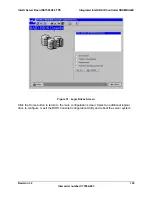
Integrated Intel® RAID Controller SROMBU42E
Intel® Server Board SE7520AF2 TPS
90
Revision
1.2
Intel order number C77866-003
4.4.2
RAID 1 - Disk Mirroring/Disk Duplexing
In RAID 1, all data is stored twice, once each on two identical hard disks making one drive a
“mirror” image of the other. When one hard disk fails, all data is immediately available on the
other without any impact on performance and data integrity.
With Disk Mirroring, two hard disks are mirrored on one I/O channel. If each hard disk is
connected to a separate I/O channel, it is called Disk Duplexing.
RAID 1 represents an easy and highly efficient solution for data security and system availability.
It is especially suitable for installations that are not too large (the available capacity is only half
of the installed capacity). Disk mirroring requires two drives and each mirrored set is limited to
two drives.
Figure 21. RAID 1
4.4.3
RAID 5 - Data Striping with Striped Parity
RAID 5 works in the same way as RAID 0. The data is striped across the hard disks and the
controller calculates redundancy data (parity information) that is striped across all hard disks.
Should one hard disk fail, all data remains fully available. Missing data is recalculated from
existing data and parity information. The RAID 5 disk array delivers a balanced throughput.
Even with small data blocks, which are very likely in a multi-tasking and multi-user environment,
the response time is very good. RAID 5 is particularly suitable for systems with medium to large
capacity requirements, due to the efficient ratio of installed and available capacity. RAID 5
requires a minimum of three drives in the configuration but can expand to the physical drive
capacity of the controller.






























